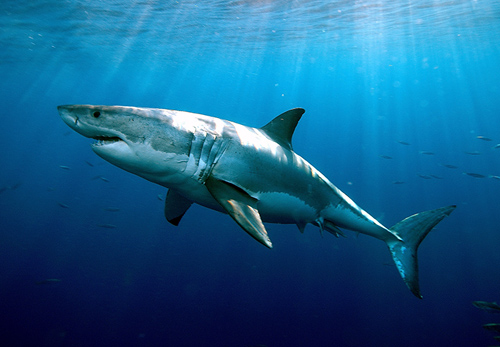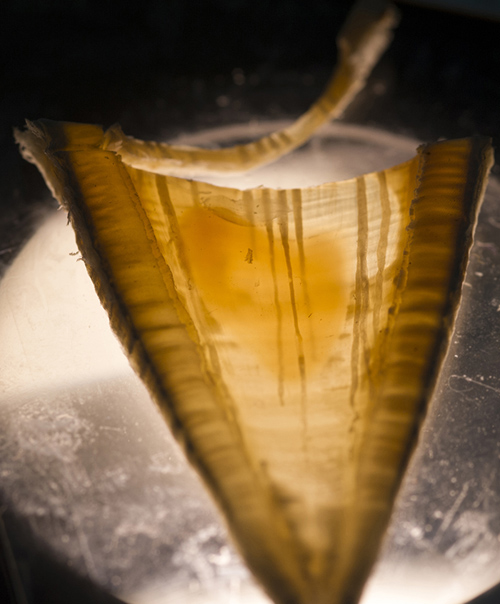Great white sharks—top predators throughout the world’s ocean—grow much slower and live significantly longer than previously thought, according to a new study led by the Woods Hole Oceanographic Institution (WHOI).
In the first successful radiocarbon age validation study for adult white sharks, researchers analyzed vertebrae from four females and four males from the northwestern Atlantic Ocean. Age estimates were up to 73 years old for the largest male and 40 years old for the largest female.
“Our results dramatically extend the maximum age and longevity of white sharks compared to earlier studies,” said Li Ling Hamady, MIT/WHOI Joint Program student and lead author of the study published in PLOS ONE. “Understanding longevity of the species, growth rate, age at sexual maturity, and differences in growth between males and females are especially important for sustainable management and conservation efforts.”

White sharks are considered vulnerable worldwide. Since individuals are slow growing and mature late, white shark populations could be even more sensitive to fishing, environmental and other pressures. Image credit: Greg Skomal, MA Marine Fisheries
Age determination in fish relies primarily on analyzing growth increments in mineralized tissue, such as otoliths (ear bones), vertebrae, and fin rays. These grow throughout a fish’s life, adding annual rings, similar to growth rings in trees.
Estimating age in white sharks can be challenging. While vertebrae are constructed of layers of tissue, laid down sequentially over an individual’s lifetime, the alternating light/dark banding patterns can be narrow and less distinct than in other species, and the bands don’t necessarily signify annual growth.
“Traditionally, ageing sharks has relied on the assumption that band pairs are annual. In many cases this has been proven correct for part or all of a species life, however in more and more cases this is being disproven,” said coauthor Lisa Natanson, a fisheries biologist at NOAA’s Northeast Fisheries Science Center (NEFSC) lab in Narragansett, R.I.

“Our results dramatically extend the maximum age and longevity of white sharks compared to earlier studies,” said Li Ling Hamady, MIT/WHOI Joint Program student and lead author of the study, shown here working with vertebrae in the lab. Image credit: Tom Kleindinst, Woods Hole Oceanographic Institution
In previous studies, which assumed annual deposition of growth bands, the oldest white shark individuals identified were from the southwestern Pacific Ocean at 22 years old and the western Indian Ocean at 23 years old.
For this study, researchers took advantage of radiocarbon produced by thermonuclear device testing done during the 1950s and 1960s. Radiocarbon mixed from the atmosphere into the ocean, and was incorporated into the tissues of marine organisms living during that time period. The rise in radiocarbon—measured as ∆14C—gave researchers a specific spot in time pinpointed in the vertebra layers, which can be used as a “time stamp” to help determine the age of an animal.
The National Ocean Sciences Accelerator Mass Spectrometry Facility at WHOI conducted radiocarbon analysis on collagen in the white shark vertebrae. All of the vertebrae samples came from white sharks caught in the northwestern Atlantic Ocean from 1967 to 2010 that were archived at the NEFSC lab in Narragansett, which has the largest collection of this kind. The samples were also digitally photographed with a camera attached to a stereomicroscope using reflected light for counting growth bands.
“This research demonstrates the power of applying cutting-edge techniques in isotope geochemistry to answer fundamental questions in ocean ecology,” said co-author Simon Thorrold, a biologist at WHOI and Hamady’s Ph.D. advisor. “The radiocarbon time stamp in white shark vertebrae provides irrefutable evidence of white shark longevity that had proved to be impossible to verify using traditional age estimation methods.”

Estimating age in white sharks can be challenging. While vertebrae are constructed of layers of tissue, laid down sequentially over an individual’s lifetime, the alternating light/dark banding patterns can be narrow and less distinct than in other species, and the bands don’t necessarily signify annual growth. Image credit: Tom Kleindinst, Woods Hole Oceanographic Institution
Researchers found that band pairs are laid down on an annual basis in small to medium-large sized white sharks in the northwestern Atlantic. However, the largest individuals may experience a change in the rate of vertebral material deposition at some point after maturity, or the bands may become so thin that they are unreadable.
Assuming a lifespan estimate of 70 years or more, white sharks may be among the longest-lived cartilaginous fishes. While they are predominantly found in temperate and subtropical waters, white sharks migrate long distances and can be found throughout the global ocean.
White sharks are considered vulnerable worldwide. Since individuals are slow growing and mature late, white shark populations could be even more sensitive to fishing, environmental and other pressures.
“These findings change the way we model white shark populations and must be taken into consideration when formulating future conservation strategies,” said co-author Greg Skomal, a WHOI adjunct scientist and MA Marine Fisheries biologist.
This research was funded by a grant from the National Science Foundation, Division of Ocean Sciences.
*Source: Woods Hole Oceanographic Institution
